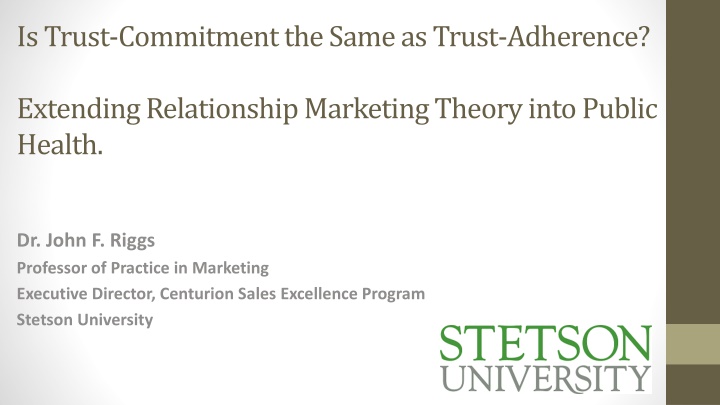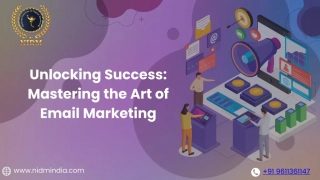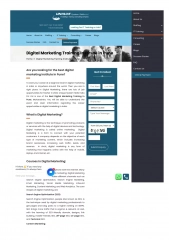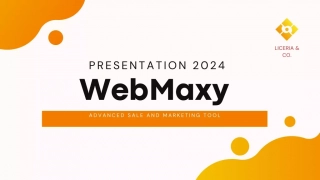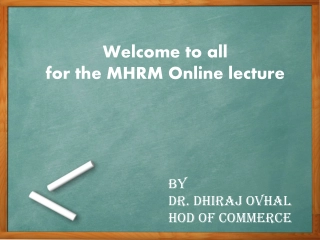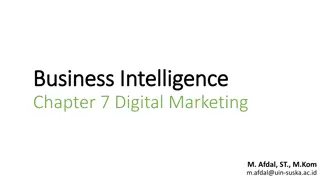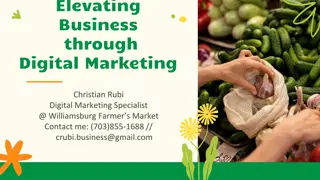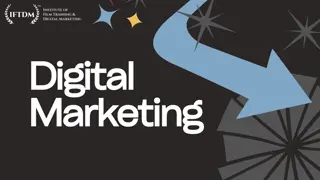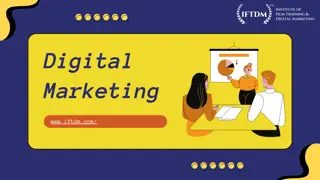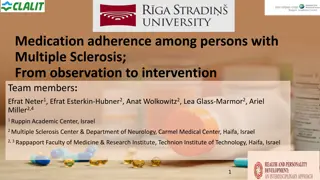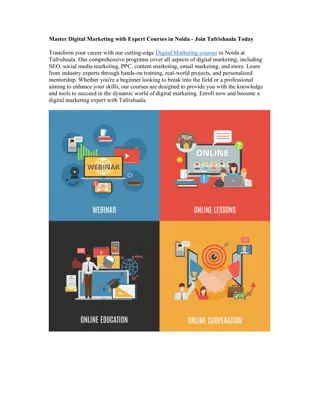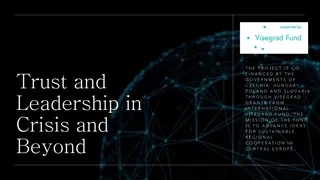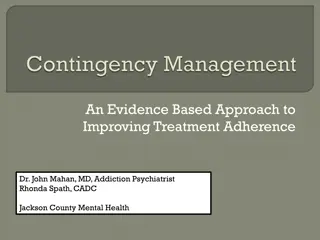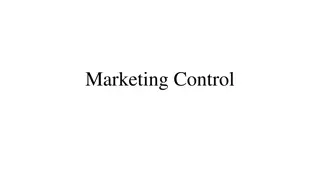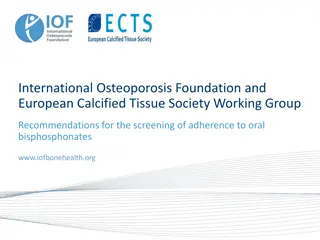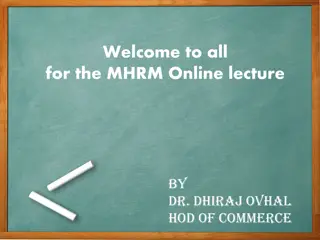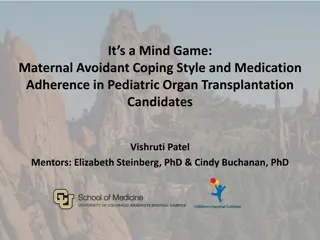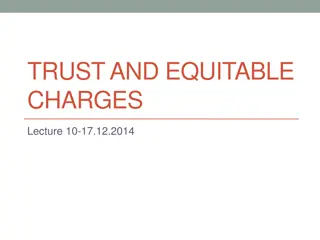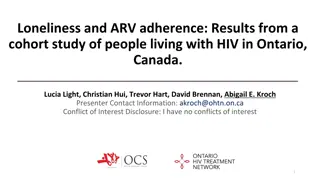Trust-Commitment vs Trust-Adherence in Relationship Marketing
Discussing the nuances between trust-commitment and trust-adherence in relationship marketing theory with practical applications, definitions, and empirical models in the context of public health. Exploring the concepts of adherence, compliance, and commitment, aiming to enhance understanding and effectiveness in business outcomes amidst challenges like information underutilization and resource constraints.
Download Presentation

Please find below an Image/Link to download the presentation.
The content on the website is provided AS IS for your information and personal use only. It may not be sold, licensed, or shared on other websites without obtaining consent from the author.If you encounter any issues during the download, it is possible that the publisher has removed the file from their server.
You are allowed to download the files provided on this website for personal or commercial use, subject to the condition that they are used lawfully. All files are the property of their respective owners.
The content on the website is provided AS IS for your information and personal use only. It may not be sold, licensed, or shared on other websites without obtaining consent from the author.
E N D
Presentation Transcript
Is Trust-Commitment the Same as Trust-Adherence? Extending Relationship Marketing Theory into Public Health. Dr. John F. Riggs Professor of Practice in Marketing Executive Director, Centurion Sales Excellence Program Stetson University
Outline: What Well Cover Today Some Definitions Adherence / Compliance Commitment Empirical Models Health Belief Model - Hochbaum, G., Rosenstock, I., & Kegels, S. (1952). Health belief model. United States Public Health Service. Commitment-Trust Theory - Morgan, R. M., & Hunt, S. D. (1994). The commitment-trust theory of relationship marketing. The journal of marketing, 20-38. Taxonomy of Sales Positions - Moncrief, W. C., Marshall, G. W., & Lassk, F. G. (2006). A contemporary taxonomy of sales positions. Journal of Personal Selling & Sales Management, 26(1), 55-65. Decision-Making Process - Elwyn, G., Frosch, D., Thomson, R., Joseph-Williams, N., Lloyd, A., Kinnersley, P., ... & Edwards, A. (2012). Shared decision making: a model for clinical practice. Journal of general internal medicine, 27(10), 1361-1367. Proposed Practical Applications
Adherence / Non-Adherence Comes from adhaerere (Latin) To cling to Keep close Remain constant In the Oxford English Dictionary (OED) it is defined as: Persistence in a practice or tenet Steady observance or maintenance
Compliance / Non-Compliance Comes from complire (Latin) To fill up and hence to complete an action, transaction, or process and to fulfil a promise. In the OED: The acting in accordance with, or the yielding to a desire, request, condition, direction, etc.; a consenting to act in conformity with; an acceding to; practical assent.
Commitment In the OED The state or quality of being dedicated to a cause, activity, etc. A pledge or undertaking. The state or an instance of being obligated or emotionally impelled.
Most Pervasive Issue in Business Today Information, education, products, and services are widely underused or not used at all. Issue: Translating effort into highly effective outcomes.
Current Observations (external validity check) Too many competing entities (pressure) Time Resources (money, people, etc.) Information overload Obtaining/ earning focused effort and attention (many competing priorities) Departure from soft-skills Methods of available communication (forced) Interpersonal effectiveness (less active) Translating thought/info into action
5 Principles (principle = rule of action ) Adapting to change in demands Readiness for Change Accurately identify consumer/ client/ customers desires Meeting patient/ consumer/ client/ customer expectations Ability to deliver desired outcomes
Theories and Models (Business) Protection Motivation Theory (PMT) Rogers 1975 The Theory of Reasoned Action (TRA) Fishbein & Ajzen 1967 Subjective Expected Utility (SEU) Theory Savage 1954
Mehrabian, A., & Ferris, S. R. (1967). Inference of attitudes from nonverbal communication in two channels. Journal of consulting psychology, 31(3), 248.
Health Belief Model A person s motivation to undertake a health behavior divided into 3 main categories: Individual Perceptions Modifying Behaviors Likelihood of Action Hochbaum, G., Rosenstock, I., & Kegels, S. (1952). Health belief model. United States Public Health Service.
Individual Perceptions Modifying Perceptions Likelihood of Action Demographics Personality SES Existing Knowledge Perceived Benefits (minus) Perceived Barriers Perceived Susceptibility/ Severity of Illness or Condition Likelihood of Behavior Change Perceived Threat of Disease or Condition Cues to Action Advice Education Symptoms Media Hochbaum, G., Rosenstock, I., & Kegels, S. (1952). Health belief model. United States Public Health Service.
EXPERTISE COMMITMENT SHARED SITUATION (CONTEXT) TRUST DEPENDABILITY COMPLETENESS (OMISSION) ADHERENCE / COMPLIANCE SOCIAL/PERSONAL CONNECTION
How Successful Firms Move People to Adopt Services/ Products/ Behaviors Ability to Persuade Change Behaviors Work Ethic Relationships Trust Rapport Technical / Clinical Knowledge
How Successful Firms Move People to Adopt Services/ Products/ Behaviors Determines my needs Feels my situation is important Work Ethic Selling Skills Solves my problems effective products/solutions/services Always recommends what is best for me Relationships Trust Rapport Technical / Clinical Knowledge
Decision Process Need/Problem Recognition Information Search Alternative Evaluation Decision Post-Decision Behavior
Decision Process The Need is the 1st and foremost step in the buying/ behavior change process. Need/Problem Recognition Information Search If there is no need, there is no purchase/ behavior change Ideal Desired Alternative Evaluation Situation Decision Actual Situation Post-Decision Behavior
Decision Process Forces that influence Needs: Basic Needs Convenience Replacement Scarcity Prestige or Aspirations Emotional Vacuum Lower Prices Greater Value Fad or Innovation Compulsory Ego Peer Pressure Reciprocity/ Guilt Need/Problem Recognition Information Search Alternative Evaluation Decision Post-Decision Behavior
Decision Process Need/Problem Recognition Information Search Alternative Evaluation Decision Post-Decision Behavior
Decision Process Once the need is identified Need/Problem Recognition Consumer/client seeks information about possible solutions to the problem. Information Search Alternative Evaluation 1. Internal information Pays more attention Friends/family/own 2. External information Decision Post-Decision Behavior
Individual Perceptions Modifying Perceptions Likelihood of Action Demographics Personality SES Existing Knowledge Perceived Benefits (minus) Perceived Barriers Perceived Susceptibility/ Severity of Illness or Condition Likelihood of Behavior Change Perceived Threat of Disease or Condition Cues to Action Advice Education Symptoms Media Hochbaum, G., Rosenstock, I., & Kegels, S. (1952). Health belief model. United States Public Health Service.
Decision Process Need/Problem Recognition Information Search Alternative Evaluation Decision Post-Decision Behavior
Decision Process Once the information is collected... Need/Problem Recognition The consumer/client evaluates the different offers available. Information Search Alternative Evaluation Determines which is most suitable to their needs based on: Features Advantages Benefits Decision Post-Decision Behavior
Decision Process Need/Problem Recognition Now, the consumer/client decides Information Search Transaction is made Behavior change is made Etc Alternative Evaluation Decision Post-Decision Behavior
Decision Process Need/Problem Recognition Once product/service is used, or behavior change is implemented Information Search Consumer/client evaluates the adequacy of choice based on sense of satisfaction. Alternative Evaluation Decision Post-Decision Behavior
Determinants of Customer/ Client Decisions MONAT, J. P. (2009). Why Customers Buy. Marketing Research, 21(1), 20-24.
Decision Process DATA is the new priority. Need/Problem Recognition Less emphasis on tactics (what) more on how. Information Search Alternative Evaluation Communication is the engine that drives successful outcomes. Decision Execution of plans ALL about people. Post-Decision Behavior
Steps Leading to Client Centered Commitment Evidence Based Business Principles Dealing with Objections Present Needs and Problem Identification Likability & Trust Close Negotiation Explain
Proposed Process Apply Solution Clearly Understand Situation (Context) Present Social / Personal Connection Address Questions / Concerns Explain Solution Action Takes Place
Questions & Comments ? Contact Information: Dr. John F. Riggs jriggs@Stetson.edu 386-822-7363
